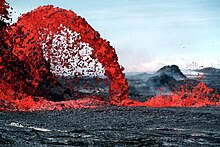The rocks can be classified according to their properties such as chemical composition, texture, permeability, among others. In any case, the criterion used is the origin, ie the mechanism of their formation. According to this criterion are classified as igneous (or magma), sedimentary and metamorphic rocks, but can be considered a separate class of altered rocks, which are studied more often among the sediments.
Igneous or magmatic
Are formed by the solidification of magma, a molten mineral mass includes volatile dissolved gases. The process is slow, when it occurs in the depths of the cortex, or faster, if it happens on the surface. The result in the first case, plutonic or intrusive rocks, consisting of thick glasses and recognizable volcanic or extrusive rocks when the magma reaches the surface, become lava degassing.
Las rocas magmáticas intrusivas son con mucho las más abundantes, forman la totalidad del manto y las partes profundas de la corteza. Son las rocas primarias, el punto de partida para la existencia en la corteza de otras rocas.
Depending on the starting magma composition, more or less rich in silica (SiO2), are classified in Ultramafic (or ultrabasic), mafic, intermediate and or sialic acid, the latter being the richest in silica. They are usually more acidic the most superficial.
The original structures of igneous rocks are the plutons, massive forms originated at great depth,the levees ,formed in the ground and filled with cracks,and lava flows ,lava flows on the surface cooled . A special case is that of the pyroclastic deposits formed by falling volcanic bombs, ash and other materials thrown into the air more or less explosive eruptions. The volcanic cones are formed with these materials, sometimes alternating with solidified lava flows (stratified cones).
Sedimentary rocks
Are formed by diagenesis (compaction and cementation) of sediment material from the surface alteration of other rocks, which are then transported and deposited by water, ice and wind, with the help of gravity or by precipitation from solutions . Also classified as sedimentary deposits organogenic materials formed by living organisms such as coral reefs, the strata of coal or oil deposits. Sedimentary rocks are those that typically have fossil remains of living organisms, although they can also be seen in some metamorphic rocks of sedimentary origin.
Sedimentary rocks are formed in the sedimentation basins, the hollows of the land to which the material carried by erosion are conducted with the help of gravity. The original structures of the sedimentary rocks are called strata, layers formed by deposition, which are formations often high power (thick).
Metamorphic rocks
Strictly is any metamorphic rock that has been produced by the evolution of a previous application to be subjected to an environment is very different from the energy of its formation, much hotter or colder, or a very different pressure. When this happens, the rock tends to evolve to stable features that make under these new conditions. The most common is the progressive metamorphism, which occurs when the rock is subjected to heat or higher pressure, but without mixing (because then we enter the realm of magmatism), but there is also a concept of regressive metamorphism, when evolved rock at great depth - under conditions of high temperature and pressure - happens to be in the area, or near where it is unstable and evolves to just that one factor triggering the process.
Metamorphic rocks are abundant in deep areas of the cortex, above the magmatic socket. Tend to distribute classified in areas other than the degree of metamorphism, as the effect of the factor involved. For example, when the cause is the heat released from a bag of magma, rocks form a halo concentric zones around the magmatic pluton. Many metamorphic rocks show the effects of pressure addressed, they do evolve to other layered minerals, and take a look laminate. Examples of metamorphic rocks are slate, marble or quartzite.












